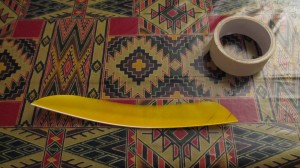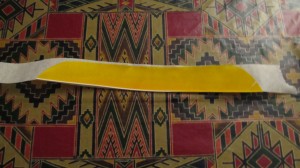Just wanted to point out Anoc of Wrapshot’s no-gimmick one-handed sword build is just as good a guide as it was when it was first posted. Now, unless you’re local to Darkon, you’re not going to be able to pick up his MC foam blade kits, but Forged Foam still sells their own well-regarded foam blades.
Latex/EL Wicked Axe by Pieter
Making plans
A friend of mine asked me if I could help him with an axe he wanted to build.
Dimensions: 110 cm (3 feet 7 inch) and double bladed.
The Inspiration
Construction
A rough design:
In the drawing you can see that the internals are drawn as well. It is better to plan ahead!
Making the parts. Knowing what goes on beforehand is a tricky part and varied from weapon to weapon, but pretend it’s real and imagine yourself a blacksmith.
The frame is made-up clued together kite spare covered in cloth.
The cloth is glued and stitched. Glued together and cut to size. Note the barbs where left out because it was felt that it would weaken the weapon. The handle is made from wood and crafted so it will take two AAA batteries. The switch is placed at the backend of the weapon and foam protected.
After some more gluing and latex-ing:
Note: 6 layers of clear latex 3 colored (black)
Than the red, and metallic are directly airbrushed on to the latex.
Covered with a coat of plastidip clear and finished with a light coat of clear varnish.
And here it is with the lights on:
Pieter’s Realistic Handmade Crossbow Fletchings
On arrows or crossbow bolts, the fletching is used to make the pointy bit of the arrow hit the target first. Without fletching an arrow won’t fly straight and could hit a target sideways, but with LARP arrows having such big heavy heads, they will actually turn midair and hit the target with the backend.
So arrows need fletchings, and LARP arrows really need big fletchings.
You will need:
- Something to make the fletching of (I use goose feathers, you could use other materials)
- Arrows
- Scissors
- Needle and thread for binding
- A mold / template
- Glue
- A clothespin to hold the feather when it is glued on the arrow
- Pencil
- Masking tape
Making a template
You will need to make a template because you need to make two very similar feather each side of your arrow. If they are to uneven the arrow will veer off in one direction. You can make a template out of paper, cardboard or plastic.
Sizing
I make my fletchings slightly longer than the cross-section of the arrow head. The height of the fletching isn’t so tall that it sticks past the arrow head.
For example, I would use the following dimensions:
The cross-section of the arrowhead is a minimum of 5 cm, so the length of the fletching is about 6 or 7 cm. The height is 0.5 * 5cm – 9 mm (half the cross-section minus the diameter of the shaft) so about 2 cm.
Shaping the Feathers
Stick some masking tape on the feather. This will make the drawing and cutting easer. Put the template on the masking tape, draw and the cut with some scissors, remove the masking tape.
Marking Guidelines
First mark out where you want to have the feathers. You do this by using a pencil and laying the arrow on a flat service and run the pencil along the shaft. Do this both sides (bolts only have two feathers) and flip the arrow and do this again. You should end up with two pairs of parallel lines on both sides of the shaft.
Gluing the Fletching onto the Bolt
I use a gluing aide and a vise. The gluing aide is to hold the feather when glue is setting. And a vise to hold the arrow nice and steady. The aide is made of two pieces of wood a cloth pick. Just to keep the feather straight. I use two more clothes picks to hold this to the shaft. Repeat on the other side.
Binding
When you have glued the flights. Then you apply the binding. The binding service a decorative purpose and a structural one.
Start with a simple knot and wind tightly towards the feather. Then use the needle to part the filaments, get the thread right in low at the base of the filament.
If done correctly, the feather should close. If it doesn’t, then probably the thread isn’t low enough, just redo it tighter. At the end just wind tightly and a few knots and some glue to stop the thread form unwinding.
And now you have a fletched bolt.
Electroluminescent Wire
Want to see something cool? Pieter of Arcana in the Netherlands shares a successful experiment in Electroluminescent Wire on a larp weapon.

Inspired by this illustration, this sword is 1.5m long, with two AAA batteries in the handle and a converter housed near the crossguard.
When powered on, the neon string lights up.
And finally, a quick video. We’d never seen this done before, it looks like a really neat way to improve a weapon for a fantasy/scifi game. Thanks for sharing your creations, Pieter!
If you’ve got something new or interesting in the world of foamsmithing, write in to contact@foamsmithing.com – we’d love to hear about it!
Pieter’s Hidden Shield Compartment
Pieter, who makes repeating crossbows sometimes, sent in this shield with a hidden compartment:
Pieter is from Arcana in the Netherlands. Thank you, Pieter!
The SoulLo Gryphon Shield, by Wrapshot
Another season, another beautiful PD shield from WrapShot. This one is commissioned by SoulLo Wartorn.
Sasha: The Six-Bolt Repeating Crossbow
Pieter from the Netherlands has built a repeating crossbow named Sasha (Team Fortress 2 reference) that fires larp arrows:
Sasha is 1.10 meters and 5.5 kg. Here it is a video of it this weapon in action!
Stuff Maker’s Weapons Rack
I have never seen a better use for seven sticks on a foam fighting field.
NQ! Heater Shield
Another killer Plastidip shield from wrapshot, this time a No Quarter! heater shield.

Click through and note the location of the handles. Not horizontal, but diagonal.
Hi-Tech Sword Building for New People
Solusar of Belegarth has a great gallery/tutorial on his blue sword build, with good details like tip-foam teeth, a tip-biscuit, and a non-mushroom-cap stabbing tip. Lots of interesting commentary. We recommend it highly: Solusar’s Hi-Tech Sword Building for New People

















